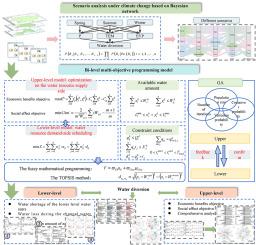基于贝叶斯网络的不确定性农业用水管理与分配优化的双层多目标规划模型
IF 10
1区 环境科学与生态学
Q1 ENGINEERING, ENVIRONMENTAL
引用次数: 0
摘要
灌区水资源管理对保障农业生产、促进区域经济发展、维护社会稳定具有举足轻重的作用。在气候变化背景下,建立科学合理的灌区水资源分配模式已成为灌区可持续发展的关键研究领域。本研究探讨了不确定条件下农业用水管理的方法组合,包括贝叶斯网络、区间参数规划和双层多目标规划模型方法。贝叶斯网络已被证明可以量化降水、温度、蒸发和其他因素对引水的非线性影响。双层多目标规划模型旨在平衡宏观和微观决策层面的经济效率和社会公平。以陕西省交口灌区为例,验证了该模型在不同情景下的适应性。结果表明:在正常情景下,灌区的总效益可达3.30 × 109元。引水均值波动小于15%左右。基尼系数保持在0.02 ~ 0.29的范围内。通过多模型耦合,合理动态配置水资源,实现农业水资源的科学管理。它为在灌区层面协调实施可持续发展目标提供了新颖的概念和专业的技术援助,旨在解决水资源短缺和不确定性带来的日益复杂的挑战。本文章由计算机程序翻译,如有差异,请以英文原文为准。

A Bayesian network-based bi-level multi-objective programming model for uncertainty agricultural water management and allocation optimization
Water resource management in irrigation districts is of pivotal importance for safeguarding agricultural production, promoting regional economic development, and maintaining social stability. The development of a scientific and reasonable water allocation model has emerged as a pivotal research area in the context of sustainable development of irrigation districts, particularly in the context of climate change. This study explores the use of a combination of methodologies for agricultural water management under uncertainty conditions, including Bayesian network, interval parameter programming, and a bi-level multi-objective programming model approach. The Bayesian network has been demonstrated to quantify the nonlinear effects of precipitation, temperature, evaporation, and other factors on water diversion. The bi-level multi-objective programming model is designed to balance economic efficiency and social equity between the macro and micro decision-making levels. A case study conducted in Jiaokou Irrigation District, Shaanxi Province of China, demonstrated the adaptability of the model under different scenarios. The findings indicate that the aggregate benefits of the irrigation district under the normal scenario can amount to 3.30 × 109 yuan. The fluctuation in the mean value of water diversion is less than about 15 %. The Gini coefficient is maintained within the range of 0.02–0.29. This study rationally and dynamically allocates water resources through multi-model coupling, achieving scientific management of agricultural water resources. It offers novel concepts and specialized technical assistance for the harmonized implementation of the Sustainable Development Goals at the irrigation district level, with the objective of addressing the progressively intricate challenges posed by water scarcity and uncertainty.
求助全文
通过发布文献求助,成功后即可免费获取论文全文。
去求助
来源期刊

Journal of Cleaner Production
环境科学-工程:环境
CiteScore
20.40
自引率
9.00%
发文量
4720
审稿时长
111 days
期刊介绍:
The Journal of Cleaner Production is an international, transdisciplinary journal that addresses and discusses theoretical and practical Cleaner Production, Environmental, and Sustainability issues. It aims to help societies become more sustainable by focusing on the concept of 'Cleaner Production', which aims at preventing waste production and increasing efficiencies in energy, water, resources, and human capital use. The journal serves as a platform for corporations, governments, education institutions, regions, and societies to engage in discussions and research related to Cleaner Production, environmental, and sustainability practices.
 求助内容:
求助内容: 应助结果提醒方式:
应助结果提醒方式:


